Five Great Public Waterfowling Destinations in Pacific Flyway
2016 public waterfowling opportunities
2016 public waterfowling opportunities

By Devin Blankenship
Freelance hunting opportunities abound on these prime destinations for western waterfowlers
California's picturesque Modoc National Wildlife Refuge (NWR) offers hunters a glimpse into the past, when waterfowl were more abundant and hunters were few.
"Typically you are hunting in a beautiful setting without the crowds that you often encounter on many of California's Central Valley refuges," says Modoc NWR manager Steve Clay. "Other than on opening weekend, when there is a draw for hunting spots, you can just fill out your card and go hunting. We open the gates and hunters check in and check out on their own."
Situated along the Pit River in Modoc County, this 7,021-acre refuge is part of a larger complex of wetlands and lakes in the northeastern part of the state. These high-desert wetlands provide important staging habitat for ducks, geese, and other wetland birds migrating to the Central Valley for the winter.
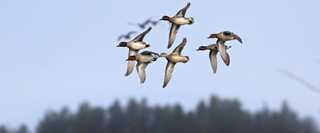
Photo Michael Furtman
Clay says hunting on the refuge is usually best early in the season before cold weather sets in. Many hunters who frequent Modoc NWR also hunt on surrounding refuges and reservoirs that border the refuge. Clay reports that the most commonly harvested species are mallards and gadwalls followed by American green-winged teal and northern shovelers.
"I would recommend that potential visitors call us before planning a hunt on the refuge," Clay says. "All of the staff here are hunters, and we are happy to provide information about what is happening and where to go. You can also scout the refuge very easily from surrounding roads."
For more information, visit https://www.fws.gov/refuge/Modoc/visit/HuntingRegulations.html
Located in the San Francisco Bay area north of San Pablo Bay, the 15,200-acre Napa-Sonoma Marshes Wildlife Area offers remarkably good public hunting opportunities in an urban setting. The area consists of a variety of habitats, including managed tidal and freshwater ponds, seasonally flooded wetlands, and diked former agricultural bay lands. The most common waterfowl species are American wigeon, canvasbacks, gadwalls, American green-winged teal, scaup, buffleheads, northern pintails, mallards, and Canada geese.
"The hunting is best when storms or fog force waterfowl off the bay and into more sheltered locations," says Tom Huffman, habitat supervisor on Napa-Sonoma Marshes Wildlife Area. "There are no permanent blinds and waterfowl hunters are encouraged to haul decoys and material for temporary blinds out of the field after each visit. Waterfowl hunters who walk in are encouraged to watch their footing as deep mud and hidden tidal channels are quite prevalent, and those using boats are encouraged to dress properly, have personal flotation gear, and check daily tide tables before setting out."
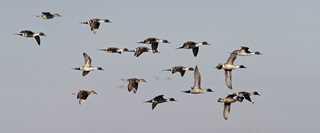
Photo Michael Furtman
Napa-Sonoma Marshes Wildlife Area consists of the Huichica Creek, Napa River, Southern Crossing, Ringstrom Bay, Wingo, Tolay Creek, Sonoma Creek, White Slough, Green Island, and American Canyon Units. No permits, passes, or reservations are required to hunt the area, which is managed by the state of California. Hunting is allowed on Saturday, Sunday, and Wednesday during open waterfowl seasons. For more information, visit https://www.wildlife.ca.gov/Lands/Places-to-Visit/Napa-Sonoma-Marshes-WA#12114207-hunting.
Southwestern Washington's Willapa NWR has long been one of the best public waterfowling areas in the Pacific Flyway. Located north of Portland along the Pacific coast, the refuge was established in 1937 to protect this pristine estuary from development and to provide habitat for migrating waterfowl and other birds.
"The water quality is great, the habitat is phenomenal, and the birds really respond to it," says Willapa NWR manager Jackie Ferrier. "We already have huge groups of teal and geese coming in. It's a great place to hunt and see a lot of birds, especially early in the season."
Willapa NWR encompasses more than 16,000 acres of uplands and tidelands, which are divided into several management units. Common waterfowl species include northern pintails, American wigeon, American green-winged teal, cackling geese, greater white-fronted geese, and Pacific brant.
"Our Riekkola Unit has managed blinds, which are available on a first-come, first-served basis, but the other units that are open to hunting are free roam," Ferrier says. "Hunters should be cautious about the tides and their footing, which can be treacherous. You can access both the managed blinds and free-roam areas from Riekkola. We are currently working on a restoration project that will provide even better access to the middle of the bay."
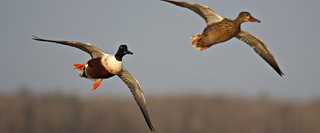
Photo Michael Furtman
State waterfowl hunting regulations as well as special refuge rules apply. For more information, visit https://www.fws.gov/refuge/willapa/visitor_activities/hunting.html.
Following a wet spring, Merced NWR is once again poised to take its place among California's top public waterfowl hunting areas. Located north of Fresno, the refuge encompasses 10,258 acres of wetlands, native grasslands, vernal pools, and riparian areas.
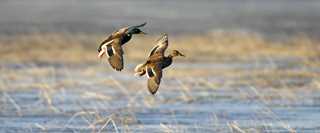
Photo Michael Furtman
"This is the first time we've had a typical water supply in four years. That allowed us to irrigate most of our moist-soil units, which provide crucial food resources for visiting waterfowl," says Bob Parris, deputy refuge manager at the San Luis National Wildlife Refuge Complex. "Flood-up is well advanced at this point, so we're expecting a much more typical year. Hunters should have plenty of opportunities to see and harvest a lot of birds this season."
Merced NWR typical hosts 20,000 sandhill cranes and 60,000 Arctic geese as well as a great abundance and diversity of ducks. According to Parris, visitors can expect to see a lot of ducks and a heavy concentration of geese beginning in early November.
Waterfowl hunting is allowed in designated areas on Wednesday and Saturday mornings. For more information, visit https://www.fws.gov/refuge/merced/hunt_maps.html.
Located 60 miles east of Reno, Stillwater NWR is Nevada's top public waterfowl hunting destination. Listed as a Globally Important Bird Area by the American Bird Conservancy and an Important Bird Area by the National Audubon Society, Stillwater hosts nearly 250,000 waterfowl, including mallards, gadwalls, northern pintails, canvasbacks, northern shovelers, and American green-winged teal.
"Stillwater is a true bird oasis in the rugged desert of central Nevada, supporting hundreds of thousands of migrating shorebirds and waterfowl," says DU regional biologist Jason Faridi. "In the arid west, migrating waterfowl flock to areas like Stillwater NWR to rest and feed."
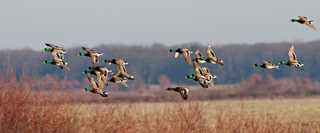
Photo Michael Furtman
During 2016, much-needed precipitation in the Carson River watershed improved habitat conditions on Stillwater NWR. Public hunting opportunities are currently available on the Goose Lake and South Nutgrass units.
"Recent surveys show active waterfowl use of the refuge. However, timing is crucial to success, and scouting is recommended in designated hunting areas," Faridi says. "While all state and federal rules and limits apply, no special permits or fees are required to hunt waterfowl on the refuge."
Hunting hours are one-half hour before sunrise to sunset. For more information, visit https://www.fws.gov/refuge/Stillwater/visit/visitor_activities.html
Ducks Unlimited uses cookies to enhance your browsing experience, optimize site functionality, analyze traffic, and deliver personalized advertising through third parties. By continuing to use this site, you agree to our use of cookies. View Privacy Policy